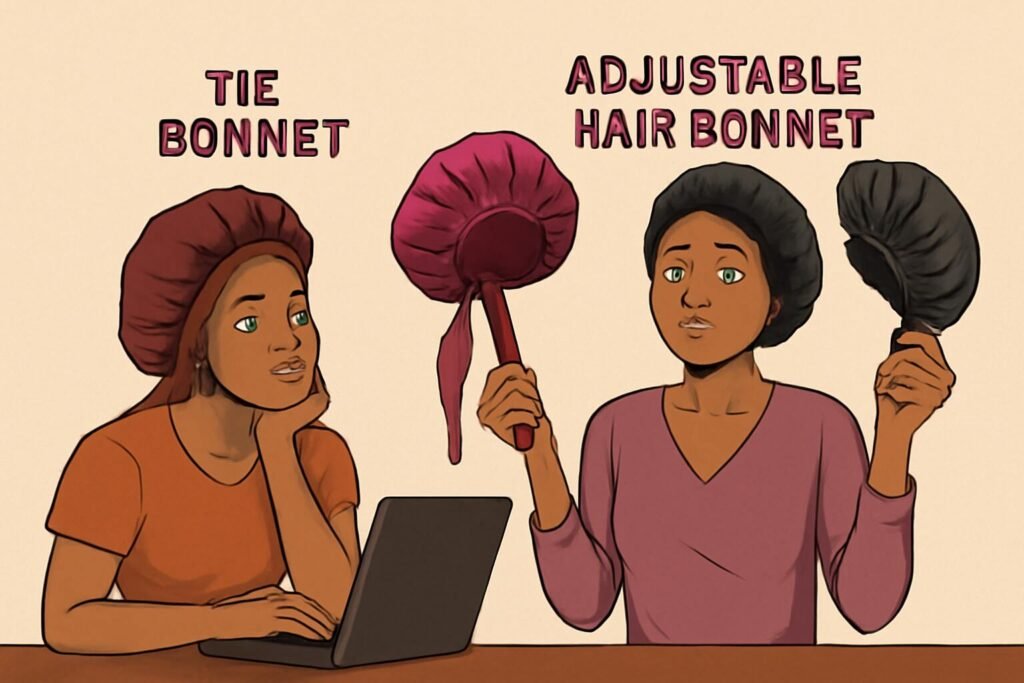Your hair deserves the best protection while you sleep—but choosing the wrong Hair Bonnet bonnet can leave you frustrated, uncomfortable, and stuck with a useless purchase. Hair bonnets play a vital role in protecting your strands from breakage, frizz, and moisture loss while you sleep.
The right bonnet locks in moisture, reduces breakage, and keeps your hairstyle Healthier fresh—but should you choose a tie bonnet or an adjustable one?
I’ve tested both, and in this no-fluff comparison, I’ll break down:
- Which bonnet stays put all night (so you wake up with zero frizz)
- Which one is easiest to use (no annoying morning tangles)
- The best pick for different hair types & budgets
- A sneaky trick to make ANY bonnet more comfortable
Let’s settle this debate once and for all.
🔍 Quick Comparison: Tie Bonnets vs. Adjustable Bonnets
| Feature | Tie Bonnets | Adjustable Bonnets | Winner? |
| Fit Customization | Fully adjustable (tie as tight/loose as you want) | Limited by elastic band | Tie Bonnet |
| Ease of Use | Takes time and practice | Quick, convenient, beginner-friendly | Adjustable Bonnet |
| Security During Sleep | Very secure if tied properly | May loosen over time with elastic wear | Tie Bonnet (More Secure) |
| Ease of Use | Takes practice to tie quickly | Slip-on in seconds | Adjustable |
| Comfort | No elastic pressure, adjustable comfort(great for headaches) | May leave marks or feel tight & Elastic can dig into forehead | Tie Bonnet |
| Longevity | Long-lasting, no elastic to wear out | Elastic band may stretch out over time | Tie Bonnet |
| Price | $8–$15 | $10–$20 | Depends on Brand |
| Hairstyle Flexibility | Can be tied differently for various hairstyles | Limited by band/strap design | Tie Bonnet |
Tie Bonnets : Pros & Cons
Pros:
- “Like a hug for your hair” – Tie it snug (but not tight) for zero slippage.
- No elastic = no headaches (ideal for sensitive scalps).
- It fits all hair volumes and is great for thick, curly, or long hair.
- Lasts forever (just wash and retie).
Cons:
- “Takes two tries to master” – First-time users might struggle with knots.
- It can come undone if you toss and turn (tip: double-knot it!).
Best for:
- Curly/coily hair (needs maximum protection)
- People who hate tight headbands
- Budget shoppers (most are under $12)
🛒 Top Pick: [Silky Tie Bonnet](Amazon Affiliate Link) – Stays put without crushing curls.
Adjustable Bonnets : Pros & Cons
Pros:
- “On in 3 seconds” – No tying, just pull and go.
- Good for travel (easy to pack and wear).
- Some have satin-lined elastic (less friction).
Cons:
- “The elastic betrayal” – Stretches out after a few months.
- Can leave a forehead mark (tight bands = morning creases).
Best for:
- Straight/fine hair (less bulk to secure)
- Lazy nights (when you just want to crash)
- People who lose patience with knots
🛒 Top Pick: [Adjustable Satin Bonnet](Amazon Affiliate Link) – Gentle elastic with extra room.
💰 Pricing Breakdown: Which Saves You More?
- Tie Bonnets: $8–$15 (long-term value)
- Adjustable Bonnets: $10–$20 (but may be replaced yearly)
💸 Sneaky Tip: Buy two tie bonnets (rotate them to extend lifespan).
🏆 Final Verdict: Which Should YOU Buy?
Choose a TIE BONNET if you:
- Have thick, curly, or long hair.
- Want zero slippage (once you master the knot)
- Prefer no elastic pressure.
Choose an ADJUSTABLE BONNET if you:
- Have fine or straight hair.
- Value speed over perfection
- Don’t mind replacing it yearly.
1. What is the main difference between tie bonnets and adjustable hair bonnets?
Tie bonnets use a customizable tie to secure the bonnet, offering a tailored fit, while adjustable bonnets rely on an elastic band for quick, convenient wear.
2. Do hair bonnets really help prevent hair breakage?
Yes, satin or silk hair bonnets reduce friction compared to cotton pillowcases, minimizing breakage and retaining moisture, especially for curly or coily hair.
3. Which bonnet is better for curly hair: tie or adjustable?
Tie bonnets are ideal for curly hair due to their secure, customizable fit, which prevents slippage and protects curls overnight.
4. Are adjustable bonnets good for fine or straight hair?
Yes, adjustable bonnets work well for fine or straight hair, as they require less bulk and are easy to slip on for quick use.
5. How do I keep a tie bonnet from slipping off at night?
Double-knot the tie or use a “turban twist” technique (available on YouTube) to ensure a secure fit, even for restless sleepers.
6. Can adjustable bonnets fit locs or braids?
Yes, but opt for “Jumbo” or extra-large adjustable bonnets to accommodate the volume of locs or braids comfortably.
7. Are tie bonnets more comfortable than adjustable bonnets?
Tie bonnets are often more comfortable, as they lack elastic bands that can cause pressure, headaches, or forehead marks.
8. How long do tie bonnets last compared to adjustable bonnets?
Tie bonnets last longer because they don’t rely on elastic, which can stretch out in adjustable bonnets after a few months.
9. Are tie bonnets harder to use than adjustable bonnets?
Tie bonnets require practice to tie securely, while adjustable bonnets are beginner-friendly, slipping on in seconds.
10. Can I use a hair bonnet for protective hairstyles like braids or twists?
Yes, both tie and adjustable bonnets work for protective styles, but tie bonnets offer more flexibility for bulkier hairstyles.
11. What material is best for hair bonnets?
Satin or silk is best, as these materials reduce friction, retain moisture, and prevent frizz compared to cotton.
12. How often should I wash my hair bonnet?
Wash your bonnet every 1–2 weeks, depending on usage, to keep it clean and prevent oil or product buildup.
13. Are tie bonnets more affordable than adjustable bonnets?
Tie bonnets typically cost $8–$15, slightly cheaper than adjustable bonnets ($10–$20), and offer better long-term value due to durability.
14. Can adjustable bonnets cause headaches?
Some adjustable bonnets may cause discomfort or headaches if the elastic band is too tight, unlike tie bonnets, which avoid this issue.
15. How can I make my bonnet more comfortable for sleeping?
Add a satin scarf between your hair and the bonnet to reduce friction, protect edges, and enhance moisture retention for a comfier fit.
✨ Your Next Step
👉 Tie Bonnet Lovers: [Grab this bestseller](Affiliate Link) – It’s spacious, stays knotted, and under $10.
👉 Adjustable Fans: [Try this satin-lined pick](Affiliate Link) – No-tie convenience with less frizz.
Tell me in the comments: Which bonnet saved YOUR hair?



